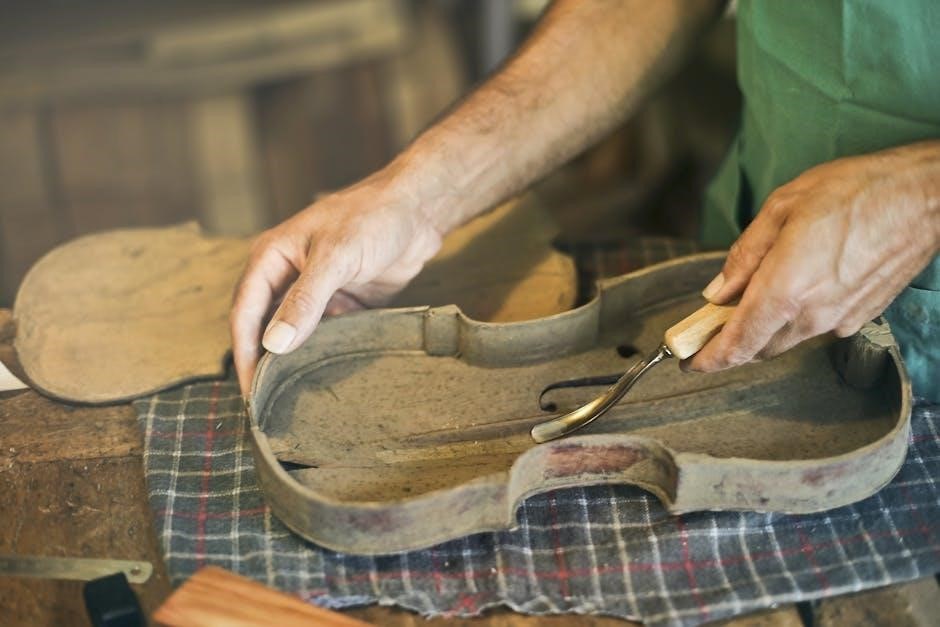The Bair Hugger 775 Service Manual is a comprehensive guide for maintaining and servicing the temperature management unit, ensuring optimal performance and patient safety. It provides detailed procedures for troubleshooting, calibration, and replacing parts, tailored for healthcare professionals and technicians. Use this manual to understand system operations, safety protocols, and compliance with regulatory standards for effective maintenance and repair.
Overview of the Bair Hugger 775 Temperature Management Unit
The Bair Hugger 775 Temperature Management Unit is a medical device designed to provide precise temperature control for patient warming. It is intended for use in healthcare settings to prevent or treat hypothermia during surgical procedures or recovery. The unit operates with 3M Patient Warming disposable components, ensuring compatibility and safety. Key features include overtemperature detection, multiple operating modes, and a user-friendly interface. It is designed to integrate seamlessly with warming blankets or gowns, maintaining optimal patient temperature. Regular servicing, as outlined in the manual, ensures reliability and compliance with safety standards. This unit is an essential tool for maintaining normothermia in patients, supporting surgical outcomes and patient comfort. Proper use and maintenance are critical for effective operation and patient safety.
Importance of Regular Maintenance and Servicing
Regular maintenance and servicing of the Bair Hugger 775 Temperature Management Unit are critical for ensuring optimal performance, safety, and compliance with medical standards. Proper servicing prevents malfunctions, extends the unit’s lifespan, and maintains patient safety. The service manual provides detailed guidelines for tasks such as calibrating sensors, testing safety systems, and replacing worn or damaged parts like filters and hoses. Regular checks help identify potential issues before they escalate, reducing downtime and ensuring reliable operation. Additionally, maintaining the unit according to the manual’s instructions ensures compliance with regulatory requirements and hospital protocols. Neglecting maintenance can lead to inaccurate temperature control, compromised patient outcomes, and potential liability. By adhering to the recommended servicing schedule, healthcare professionals can ensure the unit functions efficiently and safely, supporting effective patient care.

Safety Guidelines and Precautions
Always follow safety guidelines to avoid hazards. Ensure proper calibration, use genuine parts, and understand warning labels. Improper servicing can lead to serious injury or system malfunction.
General Safety Instructions for Servicing the Unit
When servicing the Bair Hugger 775, ensure the unit is powered off and allowed to cool before starting any maintenance. Always use genuine 3M parts to maintain safety and performance. Avoid exposing the unit to moisture, as this can damage electrical components. Ensure proper grounding of the device to prevent electrical hazards. Follow all instructions in the manual carefully, and never bypass safety features. Wear appropriate protective gear, such as gloves and safety glasses, when handling internal components. If unsure about any procedure, consult a qualified technician. Failure to adhere to these guidelines may result in injury, system malfunction, or voidance of the warranty. Regular calibration and proper servicing are critical for ensuring patient safety and optimal functionality of the temperature management unit.
Understanding Warning and Caution Labels
Warning and caution labels on the Bair Hugger 775 are critical for ensuring safe operation and servicing. Warnings indicate hazardous situations that could result in death or serious injury if not avoided, such as improper use of high-temperature settings or electrical component exposure. Cautions highlight less severe risks, like minor injury or equipment damage, such as using unauthorized parts or ignoring maintenance schedules. Always locate and read these labels before servicing the unit. They are placed on the device and detailed in the manual to guide technicians in avoiding potential dangers. Familiarize yourself with the signal words and their consequences to ensure compliance with safety protocols. Proper adherence to these labels is essential for maintaining both patient and user safety while servicing the Bair Hugger 775 Temperature Management Unit.

Service Manual Structure and Content
The Bair Hugger 775 Service Manual is organized into key sections, including introduction, safety guidelines, calibration, maintenance, troubleshooting, and record-keeping. It provides detailed instructions for efficient servicing and compliance with standards.
Key Sections of the Bair Hugger 775 Service Manual
provides an overview of the unit and its purpose. The Safety Guidelines outline critical precautions to prevent hazards. The Calibration and Testing section details procedures for ensuring accuracy and functionality. The Troubleshooting section helps identify and resolve common issues. The Replacing Parts section guides technicians on when and how to replace components like filters and hoses. Finally, the Maintenance Logs section emphasizes the importance of documenting service activities. Each section is designed to help technicians maintain the unit effectively and safely.
How to Use the Manual Effectively
To use the Bair Hugger 775 Service Manual effectively, start by reviewing the table of contents to understand its structure. Begin with the safety guidelines to ensure compliance with protocols. Familiarize yourself with the index or search function for quick access to specific sections. The calibration and testing section provides step-by-step instructions for accuracy, so follow these carefully. For troubleshooting, refer to the fault codes and solutions to diagnose and resolve issues efficiently. When replacing parts, follow the outlined procedures for filters and hoses, noting recommendations for replacement intervals. Maintain detailed service records in the Maintenance Logs section for compliance and future reference. Additionally, look for best practices or tips to enhance equipment longevity. Finally, understand the terminology used to avoid confusion. By systematically following these steps, you can optimize the Bair Hugger 775’s performance and ensure safe, effective patient care.

Calibration and Testing Procedures
Regular calibration ensures the Bair Hugger 775 operates accurately, while testing safety systems confirms proper function. Follow manual instructions for precise calibration steps and system verification procedures to maintain reliability and performance.
Calibration Requirements for Optimal Performance
Calibration is essential for ensuring the Bair Hugger 775 operates within specified temperature ranges, delivering accurate and reliable warming therapy. The service manual outlines detailed calibration procedures, including the use of specialized tools and reference points to verify system accuracy. Proper calibration ensures consistent heat delivery, preventing overheating or underheating, which could compromise patient safety or treatment efficacy. Regular recalibration is recommended, typically every 6 to 12 months, or after servicing, to maintain precision. Failure to calibrate correctly may result in system malfunctions or inaccurate temperature readings. Adhering to the manual’s guidelines ensures compliance with safety standards and optimal performance of the Bair Hugger 775. Always use authorized calibration kits and follow the step-by-step instructions provided to guarantee accurate results and maintain patient safety.
Step-by-Step Guide to Testing Safety Systems

Testing the safety systems of the Bair Hugger 775 is crucial to ensure proper function and patient protection. Begin by powering on the unit and navigating to the test mode, typically accessed via the control panel. Conduct the Overtemperature Detection Test to verify the system’s ability to detect and respond to excessive heat. Next, test all alarm functions, including temperature limits and system faults, to ensure they activate correctly. Check the integrity of sensors and connections to confirm accurate temperature readings. Finally, verify that all safety cutoffs engage as intended to prevent overheating. Each test should be performed in sequence, following the manual’s instructions to avoid errors. After completing the tests, reset the system and document the results for maintenance records. This process ensures the Bair Hugger 775 operates safely and effectively, minimizing risks during patient warming therapy.

Replacing Parts and Accessories
Replace filters and hoses regularly to maintain efficiency. Always use genuine 3M parts for safety and compatibility. Contact a 3M distributor or visit www.bairhugger.com for authentic components.

Identifying When to Replace Filters and Hoses
The Bair Hugger 775 Service Manual outlines specific criteria for replacing filters and hoses to ensure optimal performance. Filters should be replaced when they become visibly soiled or after every 500 hours of use, whichever comes first. Hoses must be inspected regularly for signs of wear, such as cracks, kinks, or discoloration. If any damage is detected, immediate replacement is necessary to prevent system malfunctions. Additionally, hoses should be replaced every two years or as specified by the manufacturer. Always refer to the manual for detailed inspection guidelines and replacement procedures to maintain patient safety and system efficiency.
Recommended Tools and Supplies for Maintenance
To perform maintenance on the Bair Hugger 775 effectively, specific tools and supplies are required. Essential tools include a multimeter for electrical checks, a torque wrench for securing connections, and a pressure gauge to verify system pressure. Additionally, replacement filters, hoses, and calibration tools are necessary to ensure optimal performance. The service manual recommends sourcing these items from authorized 3M distributors to guarantee compatibility and quality. Regularly inspecting and replenishing these supplies will help maintain the unit’s efficiency and safety. Always refer to the manual for a detailed list of recommended tools and supplies to ensure compliance with manufacturer guidelines and to prevent system malfunctions during maintenance procedures.

Troubleshooting Common Issues

The Bair Hugger 775 Service Manual provides detailed guidance for identifying and resolving common issues, including fault codes and operational problems, ensuring effective troubleshooting and system reliability.
Identifying and Resolving Fault Codes
The Bair Hugger 775 Service Manual includes a detailed section on fault codes, providing clear explanations of each code’s meaning and step-by-step solutions for resolution. Common issues such as temperature sensor malfunctions or heater performance problems are addressed with specific troubleshooting procedures. Users are guided to identify the root cause of errors, such as loose connections or faulty components, and perform corrective actions like recalibrating sensors or replacing defective parts. The manual emphasizes the importance of addressing fault codes promptly to ensure patient safety and system reliability. By following the outlined protocols, technicians can efficiently resolve issues and restore optimal functionality. This section is essential for maintaining the unit’s performance and adhering to safety standards.
Common Problems and Their Solutions
The Bair Hugger 775 Service Manual addresses several common issues that may arise during operation. One frequent problem is inaccurate temperature readings, often caused by faulty sensors or incorrect calibration. To resolve this, users should recalibrate the unit following the manual’s step-by-step guide and ensure all connections are secure. Another issue is reduced airflow, which can be due to blocked filters or kinked hoses. Regularly cleaning or replacing filters and inspecting hoses for damage can prevent this. Additionally, error codes may indicate system malfunctions, such as overheating or power supply issues. The manual provides specific troubleshooting steps for each code, including checking electrical connections and ensuring proper ventilation. By addressing these common problems promptly, users can maintain the unit’s efficiency and ensure reliable patient warming therapy.

Maintenance Logs and Record-Keeping
Maintaining detailed logs of service activities ensures compliance with safety standards and proper device functionality. Record serial numbers, maintenance dates, and calibration results for traceability and audit purposes.
Importance of Documenting Service Activities
Documenting service activities for the Bair Hugger 775 is crucial for maintaining accountability, ensuring compliance with safety standards, and providing a clear history of maintenance. Accurate records help track when procedures like calibration, filter replacements, and software updates were performed, ensuring the unit operates safely and efficiently. This documentation also serves as a reference for future servicing, reducing downtime and potential errors. Additionally, maintaining detailed logs aids in auditing and compliance with regulatory requirements, demonstrating adherence to recommended maintenance schedules. Proper record-keeping ensures continuity in care and supports troubleshooting by providing a clear understanding of the unit’s service history. Always include dates, serial numbers, and specific actions taken to ensure traceability and accountability.
Best Practices for Maintaining Service Records
Maintaining accurate and organized service records for the Bair Hugger 775 is essential for ensuring compliance, traceability, and efficient future servicing. Use standardized forms or digital tools to document all maintenance activities, including dates, procedures performed, and parts replaced. Include the serial number of the unit and the name of the technician or service provider. Store records securely, both physically and digitally, to prevent loss or damage. Regularly review and update the records to ensure completeness and accuracy. Always reference the service manual for specific documentation requirements. Additionally, ensure that all entries are signed and dated to maintain accountability. By following these practices, you can ensure that service records are reliable, accessible, and compliant with regulatory standards, supporting effective maintenance and patient safety.
